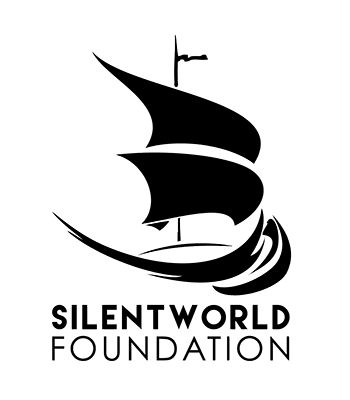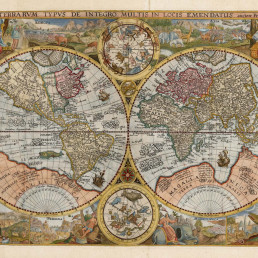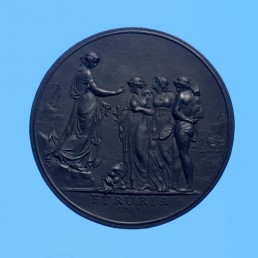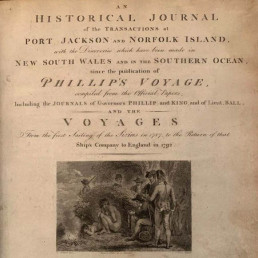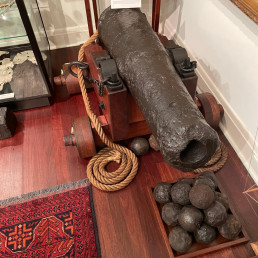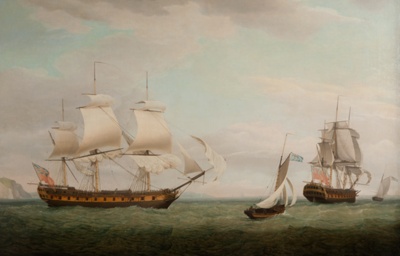
Name/TitlePortrait of the convict transport PITT
About this objectFine early oil painting of the convict transport PITT of the Third Fleet, revealing in remarkable detail numerous details of the vessel including rigging, cannons and ornamental figurehead.
This depiction of the large vessel is an important and most unusual visual record of one of the earliest convict ships to reach New South Wales. It is of further significance because PITT was one of the first such ships to be contracted by the famous East India Company, with the overt desire to take advantage of the trading possibilities in the colony and the wider region.
This ‘portrait’ of PITT was specially commissioned by the owner from English marine artist Thomas Whitcombe. Dated 1793 in the lower corner of the canvas, the painting was executed soon after the ship's return from NSW where she landed 368 convicts in February 1792. The vessel is here depicted in two positions sailing off ‘The Needles’ in the Isle of Wight. The first view shows the rigging and cannonades while the second perspective clearly reveals the name “Pitt London” lettered across the stern.
Among others, PITT carried two particularly notable passengers, one free and one detained in the hold. Major Francis Grose was the most significant person aboard as recently appointed commander of the newly formed New South Wales Corps. His fame is now matched by that of the convict artist Thomas Watling, who had been transferred on board from a hulk at Portsmouth. Watling accomplished a daring escape in Cape Town, where he was captured and held in custody awaiting the arrival of the next English convict ship: hence, although Watling was originally transported on PITT, he finally arrived on the Royal Admiral (another vessel of the Third Fleet).
As indicated by the early label attached to the frame, PITT was built by the shipwright John Wells at his yards at Gravesend on the Thames. Completed in 1780, she was owned by London Alderman George Macauley and was deployed for most of her career as an ‘East Indiaman’, running trade routes from China and India for the East India Company. Macauley had previously provided a convict transport as part owner of LADY PENHRYN of the First Fleet. Accordingly, this painting is significant as an accurate ‘portrait’ undertaken at the wishes of the owner.
Although little is known of the origins and education of the artist, by the early 1780s Thomas Whitcombe was well established in London, exhibiting at the Royal Academy most years between 1783 and 1824. He is regarded as a leading English marine painter of the later eighteenth-century, and paintings by Whitcombe relating to the early history of Australia hold pride of place in leading collections.
MakerThomas Whitcombe - Artist
Maker RoleArtist
Date Made1793
Period18th century
Medium and MaterialsOil on canvas
Place MadeLondon, United Kingdom
Inscription and MarksSigned by the artist and dated 1793
Object TypeMaritime Paintings
Object numberSF001131
Copyright Licence![]() Attribution - Non-commercial - No Derivatives (cc)
Attribution - Non-commercial - No Derivatives (cc)
Explore by category
Maps and Charts
Date range: 1541-1836
Ship Models
Date range: 1629-1890
Maritime Paintings
Date range: 1793-1849
Manuscripts and Ephemera
Date range: 1768-c1850
Medallions & Convict Tokens
Date range: 1619-1880
Landscapes
Date range: 1768-c1850
Books
Date range: 1694-c1850
Currency and Shares
Date range: 1624-1823
Printed Material
Date range: 1541-1836
Maritime Archaeology
Date range: 1629-1854
Curator's corner
New acquisitions, staff favourites and curios
The mug is decorated with an underglaze and a blue transfer print. On the body, it is titled ‘Emigrants to Australia’. This type of body and glaze was discontinued by 1840. Comparison of the handle shape and the profile of the foot, point to the attribution of manufacture by the Davenport Factory.
Delta was a ship-rigged vessel with two decks and three masts. It was built in Dordrecht, Netherlands in 1839 at the shipyard of Jan Schouten and registered in the same port. Its hull was constructed of oak and sheathed in ‘yellow metal’. Delta was owned by H. van der Sande at the time of its loss and was engaged as a cargo trader.
The Delta carried 29 crew and passengers, while sailing from Melbourne to Batavia in ballast when wrecked at Kenn Reefs on 30 May 1854 whilst under the command of Captain J.G. Kunst. This vessel loss supports the pattern of shipwrecks located on a well-travelled shipping route that was poorly charted until the mid-nineteenth century. The crew of the Delta could see four other shipwrecks at Kenn Reefs at the time of their vessel’s loss.
Important image of a ship associated with Matthew Flinders, that would shortly become one of the most famous early shipwrecks in eastern Australian waters. This is a fine ship’s portrait, by one of the great exponents of the art
